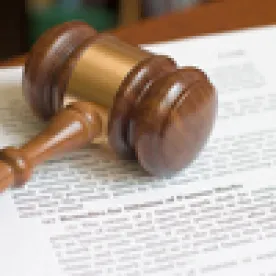In its Final Written Decision, the Board found all challenged claims of the ‘222 patent unpatentable under 35 U.S.C. § 103(a) and denied Patent Owner’s Motion to Amend. The ‘222 patent “relates to information technology (‘IT’) management and the collection of data from networks that span a wide range of institutions, including correctional facilities, without regard to which jurisdiction the source of data belongs.”
As an initial matter, because neither party challenged the Board’s claim construction on Institution, the Board incorporated its previous analysis for the decision. Specifically, the Board construed “logic of a call processing system” as “encompassing automated processes performed using logic elements and does not encompass processes performed solely by human action.”
The Board first addressed obviousness of certain claims in view of Brown. “Brown discloses a personal telephone recording system that establishes a telephone conference between two or more users.” Patent Owner challenged Petitioner for several reasons: (1) that Petitioner relies solely on attorney argument and does not cite to testimony from Petitioner’s declarant; (2) that “Petitioner fails to identify a ‘word search module’”; (3) that Petitioner fails to identify an “investigative tools module”; and (4) that Petitioner’s challenge fails because Brown lacks the claims “to place event identifiers” with “said event identifiers compris[ing] a plurality of bookmarks representing different events of interest.” The Board did not agree with Patent Owner. The Board credited Petitioner’s expert’s testimony and was “satisfied that Brown teaches or suggests an ‘investigative tools module’ comprising a ‘word search module.’” Further the Board was “satisfied that Brown teaches both bookmarking and annotation of data for word searching, thereby meeting the limitations” above. As such, the Board concluded that claim 1 would have been obvious in view of Brown.
The Board addressed obviousness in view of Brown and Gainsboro. “Gainsboro discloses a system for Automatic Speech Recognition (ASR) that identifies key words” and “is integrated with a telephone control system and recording system, specifically for correctional facilities.” The Board was not persuaded by Patent Owner’s arguments, because they failed:
(1) to explain the differences between Brown and Gainsboro, (2) to rebut satisfactorily Petitioner’s explanation of why a person of ordinary skill in the art would have combined the teachings of Brown and Gainsboro, and (3) to consider and rebut Petitioner’s arguments regarding the collective teachings of Brown and Gainsboro from the perspective of one of ordinary skill in the art. . . . To the contrary, we agree with Dr. Kaza, and find the fact that Brown and Gainsboro are in the same field (telephone communications and recording services) and address the same problem–control and management of those communications (see Ex. 1003 ¶ 100), weighs in favor of finding that a person of ordinary skill in the art would “fit the teachings” of Brown and Gainsboro together to render the challenged claims obvious.
The Board next addressed obviousness in view of Brown and Hong Kong. “Hong Kong discloses information regarding prison conditions in Hong Kong prisons under Chinese rule” and “discloses that ‘notices are prominently posted warning visitors that monitoring [of communications] occurs.’” Further, Hong Kong states that “in at least one maximum security prison, conversations between certain prisoners and their visitors are recorded.” Patent Owner argued “that Hong Kong is a report about prison conditions and is not a technical document that addresses telecommunications or monitoring of prison calls and, therefore, one of skill in the art would not look to Hong Kong for information and would not have combined it with Brown.” The Board rejected this argument, stating that “[a]lthough Hong Kong is not a technical document, it does demonstrate the state of the art and that prisons were monitoring and recording calls between inmates and visitors.” In sum, the Board found all challenged claims unpatentable.
Finally the Board addressed Patent Owner’s motion to amend “to correct the dependency of claims 15-20” that “were intended to depend from claim 14,” rather than claim 1. The Board laid out the standard Patent Owner must meet:
Patent Owner must demonstrate (1) the amendment responds to a ground of unpatentability involved in the trial; (2) the amendment does not seek to enlarge the scope of the claims of the patent or introduce new subject matter; (3) the amendment proposes a reasonable number of substitute claims; and (4) the proposed claims are supported in the original disclosure. 37 C.F.R. § 42.121.
The Board, however, was not persuaded that the requirements have been met. “Specifically, as Patent Owner notes multiple times in its Motion to Amend, the requested corrections ‘are not made in response to a ground of unpatentability involved in the [inter partes review].” Even so, “Patent Owner does not establish the proposed claims are supported in the original disclosure,” not referencing the original patent application once in its Motion to Amend, “let alone provide citations that would demonstrate written description support for the proposed corrected claims.”
The Board found all challenged claims unpatentable and denied Patent Owner’s Motion to Amend.
Global Tel*Link Corp. v. Securus Techs., Inc., IPR2014-01278
Paper 34: Final Written Decision
Dated: January 21, 2016
Patent: 7,860,222 B1
Before: Kevin F. Turner, Barbara A. Benoit, and Georgianna W. Braden
Written by: Braden
Related proceedings: Securus Techs., Inc. v. Global Tel*Link Corp., 13-3009 (N.D. Tex.); CBM2014-00166; and IPR2014-01282.



 />i
/>i

